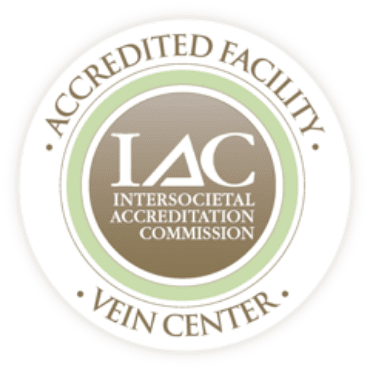What do Varicose Veins, high blood pressure, high cholesterol and diabetes mellitus have in common?
If you have been told by your physician that your varicose veins are cosmetic or pose no immediate threat or that your swollen achy legs are just something you are going to have to live with, you might want to reconsider your options. A number of patients have presented in the past months with complications of their varicose veins including clotting off of the veins (thrombosis) with progression to DVT and or with external bleeding from their varicose veins. One patient bled on the pool deck, another bled on the floor in Walmart, and a third bled in her bathtub. What all these patients and scores of other patients share in common is the fact that until the specific complication occurred, they had no severe pain or real disability from their varicose veins. Most did complain of achy or swollen legs, itching, heaviness, throbbing and heat over the veins, although none had what they would call “pain”. Most had physicians who knew about their vein problems and either had not made any specific recommendations or had suggested conservative therapy until real “pain” or other pressing complications (thrombosis, bleeding?) occurred. With the modern, minimally invasive technique of endovenous ablation available for the treatment of these patients’ vein related problems, I believe it is time to change the way we approach patients with venous insufficiency, and consider it more as the medical condition which it is rather than a “cosmetic” condition that can wait.
Many patients have traditionally been told by their primary care physicians that as long as their swollen, discolored legs don’t hurt or their varicose veins are not painful, clotted or bleeding that they should leave them alone. So, is one to conclude that active treatments should be offered only for medical conditions which are painful or have progressed to the point of complications? Hypertension has earned the nick name of “the silent killer” due to the fact that many patients with high blood pressure are unaware of their condition until a screening blood pressure reveals a high reading. Untreated or undiagnosed high blood pressure leads to premature heart attack, kidney failure, stroke and death. Similarly, active treatment of high cholesterol through weight loss, dietary modification, exercise and medication when appropriate has been shown to reduce the risk of stroke, heart attack and deaths related to hardening of the arteries. Screening blood tests for high cholesterol are routinely performed a part of an annual medical evaluation after the age of 40. Physicians are not likely to advise their patients with high cholesterol that they should wait until their first heart attack or stroke before considering active therapy. The same can be said for the treatment of diabetes mellitus. Tighter blood sugar control with dietary modification, increased physical activity and medications when needed has been shown to slow the progression of a variety of complications of diabetes including retinopathy (eye problems), nephropathy (kidney failure), neuropathy (numbness and tingling in the feet) as well as atherosclerosis (hardening of the arteries). Logic dictates a proactive approach to patients with diabetes to reduce the chances of these complications.
Venous insufficiency is a medical problem, much like the abovementioned conditions and I believe it is time we start treating it as such rather than wishing it away with unfilled compression hose prescriptions or compression hose still in their boxes. Earlier diagnosis and intervention where appropriate will reduce the long term consequences and complications of venous insufficiency such as thrombosis, bleeding, skin changes and ulceration. The modern, minimally invasive technique of endovenous ablation has made this possible.
Of the estimated 35-40 million adults in the U.S. who suffer from symptomatic superficial venous insufficiency, or venous reflux disease, the majority have symptoms and signs which cause significant discomfort. Until 2000, the only treatments available for patients with significant saphenous vein insufficiency were compression hose, high ligation or high ligation and stripping. The latter two treatments were often considered too invasive for patients with symptoms other than bleeding veins or non-healing leg or ankle venous ulcers. Therefore, most patients with venous insufficiency in the past were advised to wait until the end-complications occurred before considering anything more than compression hose. The landscape of venous insufficiency treatment was transformed dramatically by the introduction of endovenous ablation (sealing veins with heat rather than vein stripping) in 1999. The radiofrequency catheter system was the first system approved by the FDA in 1999 and the first LASER system for endovenous ablation received FDA approval in 2001.
Call Or Request An Appointment
Contact us to schedule an appointment with our expert Vein Specialists team. We will evaluate your signs and symptoms, answer your questions, and create a personalized vein care treatment plan to relieve your leg pain and enhance your life.
Schedule Your Appointment TodayOver the past decade, our understanding of venous insufficiency has been greatly improved as endovenous ablation has been applied with excellent results to patients with some of the more advanced stages of venous insufficiency. Superficial veins in the legs which cause most of varicose veins, swollen legs and skin problems due to venous insufficiency are now treatable with endovenous ablation. Modern ultrasound evaluation of the lower extremity venous system by experienced vascular technologists can accurately identify which veins are insufficient (leaking) and can be used to classify the severity of reflux or leakiness of the valves. Ultrasound directed sealing of the abnormal veins under local anesthesia has yielded far superior results than vein ligation or stripping. The net result has been relief for millions of patients worldwide and for hundreds of thousands of patients in the USA. Varicose veins are resolving, leg ulcers are being healed in record time, stasis dermatitis changes are being reversed and leg swelling and pain is receding in thousands of patients once thought to be untreatable.
So the question is when to consider getting your vein problems evaluated and whether it is wise to leave varicose veins alone until complications like superficial venous thrombosis (clotting of the varicose veins) with possible progression to deep vein thrombosis(DVT), pulmonary embolism(PE), hemorrhage(bleeding) or ulceration occur. The next time someone tells you to wait for one of the above occur before seeking evaluation or vein treatment, reflect back on the goals of treatment in patients with other medical diseases such as high blood pressure, high cholesterol and diabetes. The common goal is quite simply prevention of long term complications, not necessarily relief of “pain”. It has been 14 years since the introduction of endovenous ablation as the preferred treatment of patients with symptomatic venous insufficiency and it is time to shed more light on this safe, effective and minimally invasive treatment widely available to millions of patients still suffering from venous insufficiency.
Request an Appointment
Please take a moment and fill out your request below and one of our staff members will be in contact within 24-48 business hours. If this is an emergency, call 911 immediately. If this is a non-emergent concern, please call the office Monday-Friday between 8am – 5pm at: 239-694-8346

